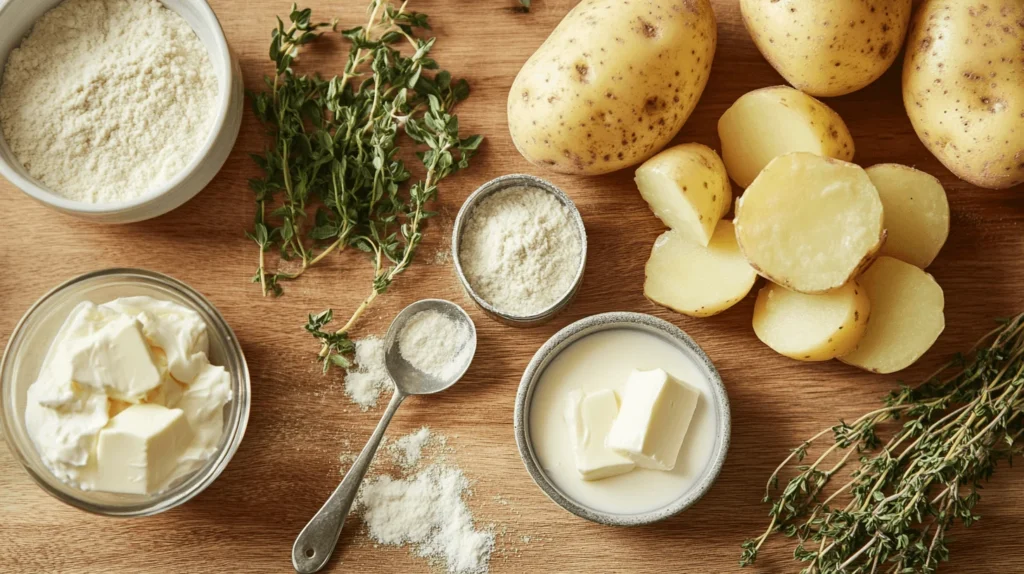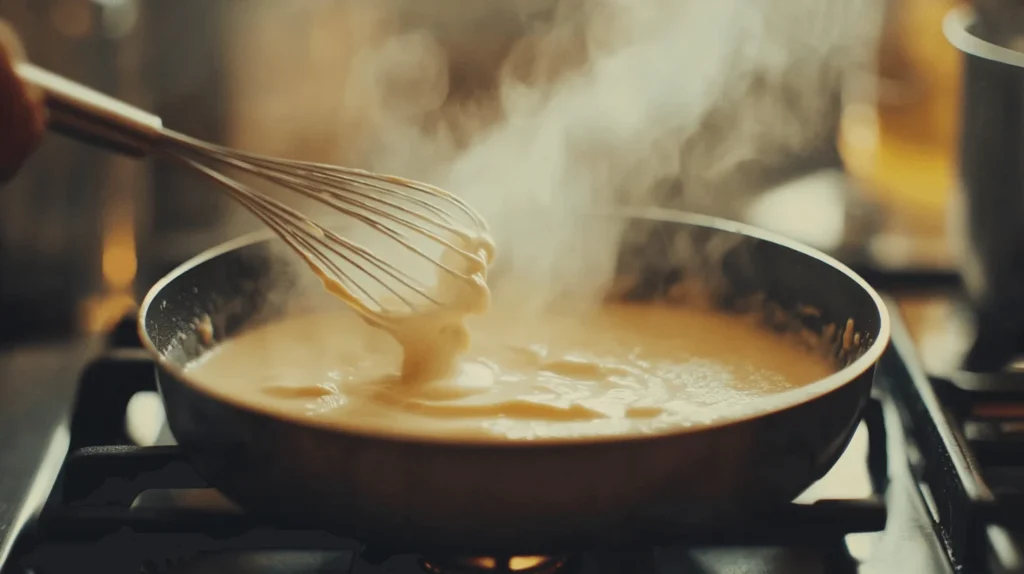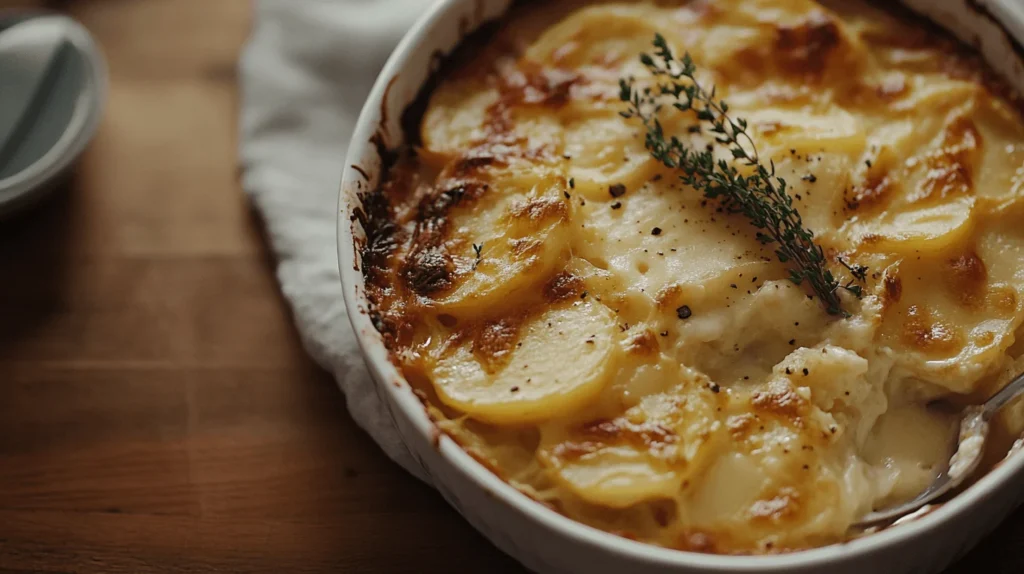Scalloped potatoes are a beloved dish, especially when combined with cheese powder to create an irresistible creamy texture. This scalloped potatoes cheese powder recipe is easy to follow and will take your family dinners or holiday meals to the next level. By using cheese powder, you can enhance the dish’s flavor without the hassle of melting fresh cheese.
With its rich flavor and smooth texture, this dish is perfect for any occasion. The best part is that the ingredients are simple, and you can easily master the technique. Let’s dive into this scalloped potatoes cheese powder recipe and learn how to make it perfectly every time.
Key Ingredients for Scalloped Potatoes with Cheese Powder
To make the perfect scalloped potatoes recipe with cheese powder, you will need a few basic ingredients. These ingredients work together to create the rich, creamy texture and savory flavor that makes this dish so irresistible.
For inspiration, check out how to add more flavor to scalloped potatoes.
Choosing the Best Potatoes for Scalloped Potatoes with Cheese Powder
When making scalloped potatoes with cheese powder, it’s essential to choose the right type of potato. The best potatoes for this dish are those that have a high starch content. Russet potatoes are a great choice because they break down during cooking, creating a soft texture. Yukon Gold potatoes also work well, as they provide a creamy consistency and a slightly buttery flavor.
Avoid using waxy potatoes like red potatoes, as they hold their shape and don’t absorb the cheese sauce as well, resulting in a less creamy dish.
Learn from Michael Symon’s trick for perfect scalloped potatoes to refine your technique.
How Cheese Powder Enhances Scalloped Potatoes Flavor
Cheese powder is a convenient and flavorful ingredient that adds a burst of cheesy goodness to your dish. Unlike fresh cheese, cheese powder is made by dehydrating cheese and then grinding it into a fine powder. The advantage of using cheese powder is that it easily dissolves into the sauce, creating a smooth and creamy texture without the need for heavy amounts of cream or milk.
Additionally, cheese powder offers a concentrated flavor, allowing you to get a bold, cheesy taste without overwhelming the dish. Some popular cheese powders include cheddar, Parmesan, and Gouda.
Explore why using cheese powder instead of cheese is a game-changer in recipes like this.
Other Essential Ingredients for Scalloped Potatoes with Cheese Powder
The key to achieving the rich and creamy texture in scalloped potatoes with cheese powder is a combination of dairy ingredients. Heavy cream, butter, and milk work together to create the base of your cheese sauce. The cream adds richness, while the milk ensures that the sauce isn’t too thick. Butter provides a subtle, savory flavor that enhances the overall taste of the dish.
To balance the richness of the cheese sauce, add a pinch of salt, pepper, and garlic powder. These spices bring out the natural flavors of the potatoes and cheese, giving the dish a savory depth.
For inspiration, check out how to add more flavor to scalloped potatoes.

Step-by-Step Process for Making Scalloped Potatoes with Cheese Powder
Now that you have all the ingredients, it’s time to get cooking. Follow this step-by-step guide to make the perfect scalloped potatoes with cheese powder.
Preparation of Potatoes: Peeling, Slicing, and Rinsing
The first step is to prepare the potatoes. Start by peeling them, then slice them into thin, uniform rounds. The thickness of the slices is important because it affects how evenly they cook. Aim for slices that are about 1/8-inch thick. After slicing, rinse the potatoes under cold water to remove excess starch. This will help them cook evenly and prevent them from becoming too mushy during baking.
Making the Creamy Cheese Sauce with Powder
In a saucepan, melt butter over medium heat. Once melted, add flour and whisk it for about 1-2 minutes to make a roux. Gradually pour in the milk and cream while continuing to whisk to prevent lumps. Bring the mixture to a simmer, then stir in the cheese powder. Let the sauce cook for an additional 2-3 minutes, allowing the cheese powder to fully dissolve and create a smooth, creamy consistency. Season with salt, pepper, and garlic powder to taste.

Layering and Baking Techniques for Perfect Texture
Now that the sauce is ready, it’s time to layer the potatoes. In a greased baking dish, arrange a layer of potato slices at the bottom. Pour a small amount of the cheese sauce over the potatoes, then repeat the process, layering potatoes and sauce until you run out of ingredients. Cover the dish with foil and bake in a preheated oven at 350°F (175°C) for 45 minutes. After this time, remove the foil and bake for an additional 15 minutes to allow the top to brown and become crispy.

The Science of Scalloped Potatoes
Understanding the science behind scalloped potatoes with cheese powder can help you achieve the perfect dish every time. The interaction between the cheese powder, dairy, and potatoes is what gives this dish its signature creamy texture.
How Cheese Powder Interacts with Dairy Products to Create a Creamy Sauce
When cheese powder is added to dairy products like milk and cream, it dissolves into the liquid, forming a smooth sauce. The fat content of the cream and butter helps to bind the cheese powder to the potatoes, creating a rich and velvety texture. This interaction is essential for achieving the creamy, cheesy consistency that makes scalloped potatoes with cheese powder so irresistible.
Why the Potato Slices Cook Perfectly in Layers
The reason why scalloped potatoes cook so perfectly in layers is due to the way the starch in the potatoes interacts with the sauce. As the potatoes cook, the starch breaks down, helping to thicken the sauce and bind the layers together. This creates a cohesive dish with tender potatoes and a smooth, creamy texture that is hard to resist.
Best Types of Cheese Powder to Use
When it comes to choosing the right cheese powder for your scalloped potatoes recipe with cheese powder, there are several options. Each type of cheese powder has its unique flavor profile, so you can customize the dish to your liking.
Popular Cheese Powders: Cheddar, Parmesan, and Gouda
Cheddar cheese powder is one of the most popular options for scalloped potatoes with cheese powder. It has a bold, tangy flavor that pairs well with the creamy texture of the potatoes. Parmesan cheese powder adds a sharp, nutty flavor to the dish, while Gouda cheese powder brings a smooth, smoky richness. These three types of cheese powders are versatile and can be used alone or in combination to create a unique flavor.
Comparing Flavors and Textures of Different Cheese Powders
Cheddar cheese powder offers a classic, savory taste, while Parmesan adds an aged, tangy flavor that complements the richness of the dish. Gouda cheese powder, on the other hand, imparts a creamy, slightly sweet taste. Depending on your preference, you can mix and match different types of cheese powders to create a flavor profile that best suits your taste.
How to Customize Your Scalloped Potatoes with Cheese Powder
One of the best things about scalloped potatoes with cheese powder is how easily it can be customized. Whether you want to add extra vegetables or try different types of cheese powder, there are endless possibilities for making this dish your own.
Adding Vegetables Like Onions, Garlic, and Spinach
You can enhance the flavor of your scalloped potatoes with cheese powder by adding vegetables. Onions and garlic bring a savory depth to the dish, while spinach adds a burst of color and nutrients. Simply sauté the onions and garlic before adding them to the layers of potatoes, or toss the spinach in the cheese sauce for added flavor.
Using Different Types of Cheese Powders for a Unique Twist
For a unique twist, experiment with different cheese powders. Try a blend of sharp cheddar and smoky Gouda for a flavor-packed combination. Alternatively, use a mild cheese like mozzarella for a creamy, subtle taste. The possibilities are endless, so don’t be afraid to get creative with your choice of cheese powder.
Common Mistakes to Avoid in Scalloped Potatoes Recipes
When making scalloped potatoes with cheese powder, there are a few common mistakes that can affect the final dish. Avoiding these pitfalls will help you achieve the perfect texture and flavor every time.
Not Slicing Potatoes Evenly for Uniform Cooking
One of the most important steps in making scalloped potatoes is slicing the potatoes evenly. If the slices are too thick or uneven, some pieces will cook faster than others, resulting in a dish with both undercooked and overcooked potatoes. Use a sharp knife or mandolin to ensure uniform slices for even cooking.
Over or Undercooking the Potatoes
It’s essential to monitor the cooking time carefully to avoid over or undercooking the potatoes. If the potatoes are undercooked, they’ll be hard and crunchy, while overcooked potatoes can turn mushy. Keep an eye on the baking time, and use a fork to check for tenderness before removing the dish from the oven.
Tips for Perfecting Your Scalloped Potatoes
To perfect your scalloped potatoes with cheese powder, follow these helpful tips.
Choosing the Right Baking Dish
The size and shape of your baking dish can affect the cooking time and the final texture of your dish. A deeper dish may require more time for the potatoes to cook through, while a shallower dish will allow the sauce to thicken more quickly. Choose a baking dish that will allow the potatoes to cook evenly.
Adjusting Cooking Times for Thick or Thin Potato Slices
If you slice your potatoes thicker than recommended, you may need to adjust the cooking time. Thicker slices will take longer to cook, so keep them covered with foil for the first portion of the baking time and remove it at the end to allow the top to brown.
Variations of Scalloped Potatoes with Cheese Powder
While the classic version of scalloped potatoes with cheese powder is delicious on its own, you can make variations to suit different dietary preferences and flavor profiles.
Vegan and Dairy-Free Versions Using Plant-Based Ingredients
For a vegan or dairy-free version of scalloped potatoes with cheese powder, you can use plant-based ingredients. Replace dairy with almond milk, coconut cream, or oat milk for a creamy texture. Use vegan butter and a dairy-free cheese powder to keep the dish rich and flavorful without any animal products.
Incorporating Meats Like Bacon or Ham into the Dish
For a meatier version of scalloped potatoes with cheese powder, consider adding bacon or ham. Bacon adds a smoky crunch, while ham provides a savory, salty flavor. Simply layer the meat with the potatoes or sprinkle it on top for added texture and flavor.
Nutritional Benefits of Scalloped Potatoes with Cheese Powder
While scalloped potatoes with cheese powder is a rich and indulgent dish, it can also offer nutritional benefits when enjoyed in moderation.
How Potatoes and Cheese Powder Contribute to a Balanced Meal
Potatoes are a good source of carbohydrates, providing energy and fiber. When combined with cheese powder, which offers protein and calcium, the dish becomes a more balanced meal. The dairy in the cheese powder also provides essential vitamins and minerals, contributing to a well-rounded diet.
Discussing Calories, Proteins, and Fats in the Dish
While scalloped potatoes with cheese powder is rich in calories and fats due to the cream and cheese powder, it also provides a decent amount of protein. A serving of this dish can range from 200 to 300 calories, depending on the amount of cream and cheese powder used. It’s a satisfying and filling dish that pairs well with lean proteins or vegetables to create a more balanced meal.
Pairing Scalloped Potatoes with Cheese Powder with Other Dishes
To create a complete meal, scalloped potatoes with cheese powder pairs well with a variety of side dishes.
Best Protein Sides to Complement Scalloped Potatoes
Scalloped potatoes are rich and hearty, so pairing them with a lean protein like grilled chicken, roasted turkey, or baked fish creates a well-rounded meal. The savory flavor of the potatoes complements the protein without overpowering it.
Salads and Breads That Go Well with Scalloped Potatoes with Cheese Powder
For a fresh contrast to the rich potatoes, serve a crisp salad with a tangy vinaigrette. A simple mixed green salad with a lemon-based dressing works well. Additionally, a slice of crusty bread or dinner rolls can help soak up the delicious cheese sauce.
Frequently Asked Questions (FAQs)
- How do I store and reheat leftover scalloped potatoes?
- Store leftover scalloped potatoes with cheese powder in an airtight container in the refrigerator for up to 3-4 days. Reheat in the oven at 350°F (175°C) for 10-15 minutes, or until heated through.
- Can I use cheese powder instead of cheese?
- Yes, cheese powder can replace cheese in recipes. It provides a concentrated cheese flavor but won’t add the same creaminess as fresh cheese. You can combine it with butter or cream to get a creamy texture.
- What is the one trick Michael Symon uses to make perfect scalloped potatoes?
- Michael Symon’s trick is to slice potatoes thinly and evenly using a mandolin to ensure uniform cooking and better absorption of the sauce.
- How to add more flavor to scalloped potatoes?
- Add garlic, mix different cheeses, use herbs like thyme or rosemary, and season with salt, pepper, and nutmeg for extra flavor.
- How do you make Paula Deen’s scalloped potatoes?
- To make Paula Deen’s scalloped potatoes, layer sliced potatoes and onions in a greased dish, mix heavy cream, milk, butter, salt, and pepper, pour over the potatoes, top with shredded cheddar, and bake at 350°F for 45 minutes, then uncovered for 15-20 minutes until golden.
Conclusion
Scalloped potatoes are the perfect comfort food for any occasion. With the right ingredients and techniques, you can create a creamy, cheesy dish that will impress your guests. Whether you prefer the classic recipe or want to add your own twists, this dish is sure to become a favorite at your table. Follow the step-by-step guide, experiment with different cheese options, and enjoy the rich, indulgent flavors of this timeless recipe.

